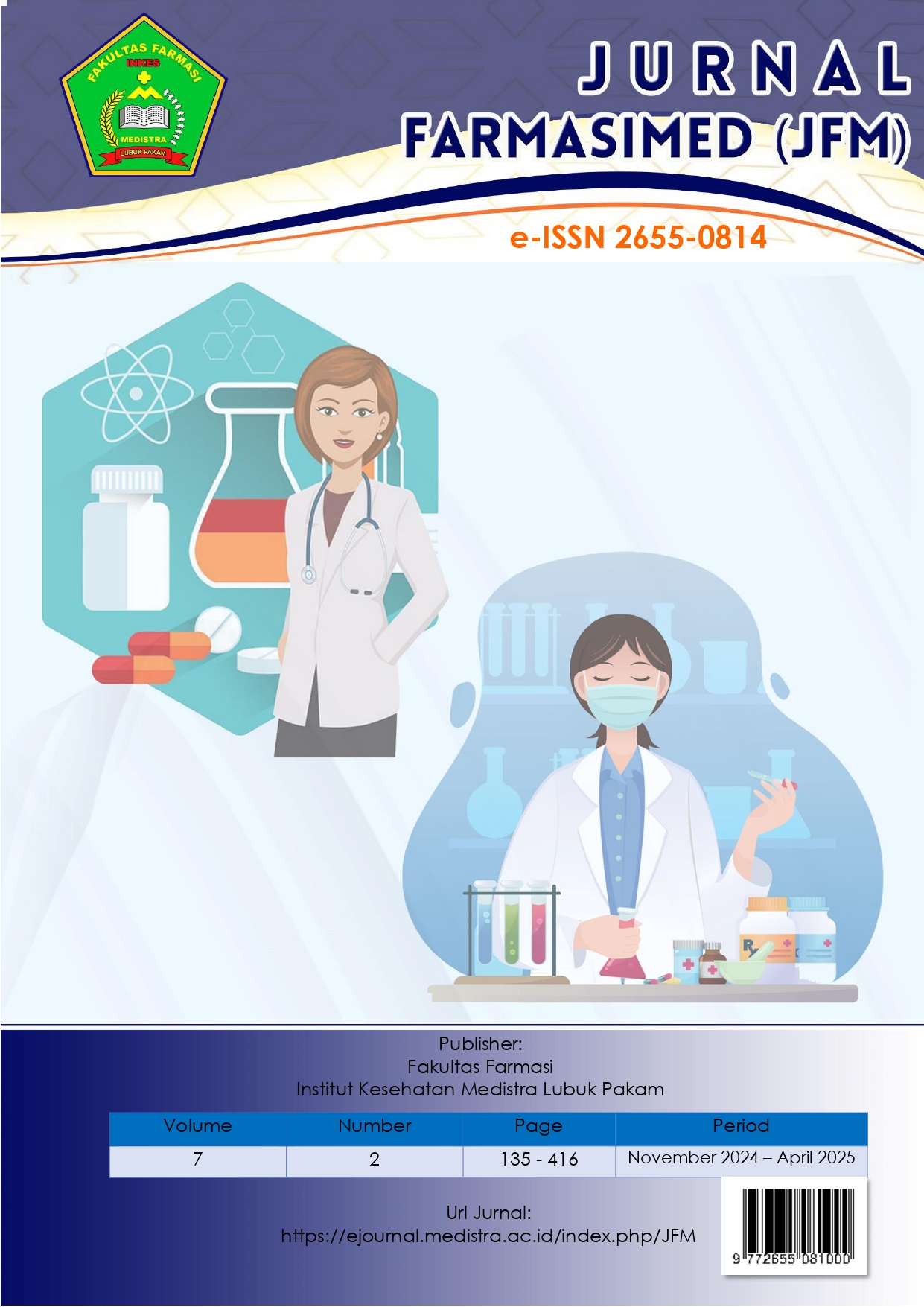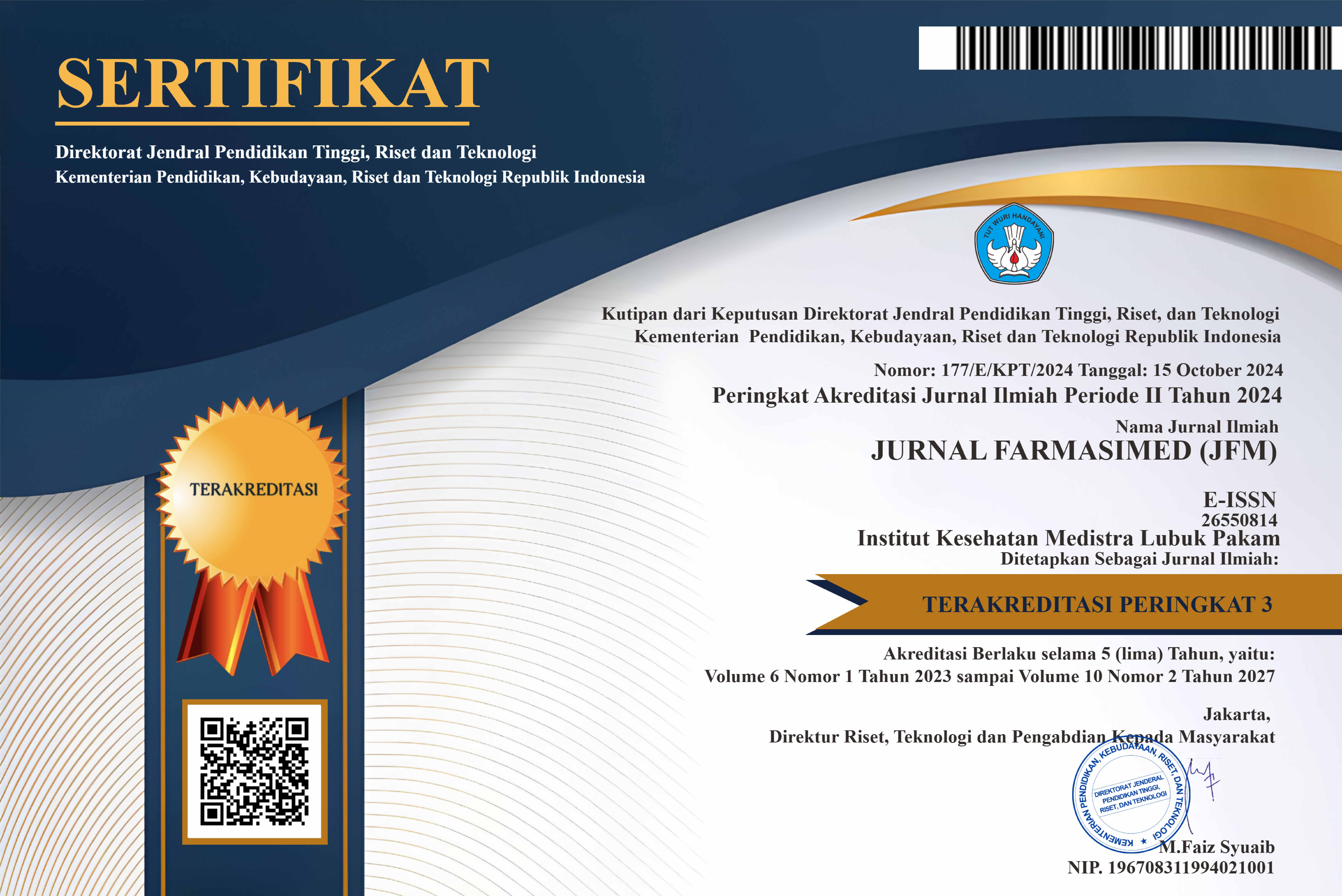Evaluation of Lotion Formulation Using Salam Leaf Extract (Syzygium polyanthum) with Antioxidant Activity
DOI:
https://doi.org/10.35451/jfm.v7i2.2440Keywords:
Bay Leaves (Syzygium polyanthum), , Antioxidant, Lotion, SkinAbstract
Bay leaves (Syzygium polyanthum) contain active compounds such as tannins, saponins, flavonoids, and steroids, which offer various benefits in skincare, including antioxidant, antimicrobial, anti-inflammatory, and natural cleansing properties. This study aimed to evaluate the antioxidant activity of bay leaf extract and assess the quality of lotion formulation containing the extract. Extraction was carried out using the maceration method with 70% ethanol as the solvent, and antioxidant activity was tested using the DPPH (2,2-diphenyl-1-picrylhydrazyl) method, yielding an IC50 value of 48.64 ppm, indicating moderate antioxidant activity. The lotion formulations were evaluated for organoleptic properties, homogeneity, pH, spreadability, viscosity, and emulsion stability. Results showed that formula F2 had superior quality compared to F1, with a spreadability of 6.5 cm (compliant with SNI 16-3499-1996), pH 6.70 (safe range 4.5–8), creamier texture, lower stickiness and greasiness, and faster absorption time (30 seconds). Formula F2 also demonstrated ideal viscosity (6805 mPaS) and shear thinning properties (torQ 68.1%), which ease application on the skin. Based on these findings, formula F2 meets the requirements for topical cosmetics according to SNI and the Indonesian Pharmacopoeia VI edition, especially in terms of pH, physical stability, and viscosity, and thus shows promising potential for development as a natural-based cosmetic product that is both safe and effective in protecting the skin from free radicals and irritation.
Downloads
References
Rahmasiah, S. Hadiq, and W. Sirajuddin, “EVALUASI PENGGUNAAN OBAT TRADISIONAL BERDASARKAN DIMENSI KETEPATAN CARA PENGGUNAAN,” Jurnal Farmasi IKIFA, 2024.
S. Nurtanti and Sulistiyoningsih, “EFEKTIVITAS REBUSAN DAUN SALAM TERHADAP PENURUNAN TEKANAN DARAH PADA PASIEN HIPERTENSI,” Jurnal Keperawatan GSH, vol. 11, no. 2, 2022.
F. Wahyu Ariyanti and N. Janna Dewi Cahyani, “PENGARUH PEMBERIAN AIR REBUSAN DAUN SALAM TERHADAP KADAR ASAM URAT PADA PENDERITA ASAM URAT DI PUSTU JASEM-NGORO MOJOKERTO,” 2020.
Y. N. Khoiriyah, “Profil Fitokimia Ekstrak Daun Salam (Eugenia polyantha Wight): Metode Infundasi, Dekoktasi, Maserasi dan Soxhletasi,” Jurnal Inovasi Farmasi Indonesia (JAFI), vol. 4, no. 2, pp. 111–123, Jun. 2023, doi: 10.30737/jafi.v4i2.4612.
A. Iga Maharani et al., “Peran Antioksidan Alami Berbahan Dasar Pangan Lokal dalam Mencegah Efek Radikal Bebas,” Inovasi Riset Biologi dalam Pendidikan dan Pengembangan Sumber Daya Lokal, 2021.
A. Makmun, B. Ilmu Kesehatan Masyarakat, and F. Kedokteran, “Hubungan Obesitas dan Stress Oksidatif,” UMI Medical Journal, vol. 6, p. 1, 2021.
I. Gede Rheza Wisnu Bhadreswara and N. Made Pitri Susanti, “Review Artikel Potensi Daun Salam (Syzygium polyanthum) Sebagai Antioksidan untuk Menangkal Radikal Bebas,” 2023.
R. Putri, G. P. Farmasi, S. Tinggi, I. Kesehatan, and T. Belas, “LOTION ANTIOKSIDAN EKSTRAK DAUN SALAM (Syzygium polyanthum Wight Walp.),” Jurnal Kesehatan Tujuh Belas, vol. 2, no. 1, p. 182, 2020.
D. Khartika Membri, A. Yudistira, and S. Sumantri Abdullah, “ANTIOXIDANT ACTIVITY TEST OF Liosina paradoxa SPONGE ETHANOL EXTRACT COLLECTED FROM MANTEHAGE ISLANDS UJI AKTIVITAS ANTIOKSIDAN EKSTRAK ETANOL SPONS Liosina paradoxa YANG DIKOLEKSI DARI PULAU MANTEHAGE,” 2021.
P. Sibua, H. E. I. Simbala, S. Datu, P. Studi, F. Fmipa, and U. Manado, “UJI AKTIVITAS ANTIOKSIDAN EKSTRAK DAUN PINANG YAKI (Areca vestiaria) DENGAN MENGGUNAKAN METODE DPPH (1,1-difenil-2-pikrilhidrazil),” 2022.
S. Widodo, N. Made Yusa, and P. Timur Ina, “Pengaruh Waktu Maserasi Terhadap Aktivitas Antioksidan Ekstrak Daun Mundu (Garcinia dulcis (Roxb.) Kurz),” Itepa: Jurnal Ilmu dan Teknologi Pangan, 2021.
L. Rahmatia, “Fitokimia dan Aktivitas Antiradikal DPPH Seduhan Daun Salam (Zysygium polyanthum Wight.),” Jurnal Ilmu Kimia dan Pendidikan Kimia, vol. 11, 2022, [Online]. Available: http://ojs.uho.ac.id/index.php/sainse-mail:
F. N. Syaputri, R. Artha Mulya, T. Daru, A. Tugon, and F. Wulandari, “Formulasi dan Uji Karakteristik Handbody Lotion yang Mengandung Ekstrak Etanol Daun Sirih Merah (Piper crocatum) Formulation and Characteristics Test of Handbody Lotion That Contain Betel Leaf Ethanol Extract Red (Piper crocatum),” FARMASIS: Jurnal Sains Farmasi, vol. 4, no. 1, 2023.
Wafa Wafa and Ofa Suzanti Betha, “Uji Stabilitas Fisik Emulsi Minyak Biji Jinten Hitam dengan Penambahan BHT,” An-Najat, vol. 1, no. 3, pp. 238–259, Aug. 2023, doi: 10.59841/an-najat.v1i3.174.
S. W. Sigiro, N. L. Arpiwi, and N. M. S. Parwanayoni, “Formulasi Body Mask dari Daun Pegagan (Centella asiatica L.) untuk Perawatan Kulit,” Metamorfosa: Journal of Biological Sciences, vol. 10, no. 1, p. 143, Apr. 2023, doi: 10.24843/metamorfosa.2023.v10.i01.p15.
M. Falsianingrum, A. Retnaningsih, and N. Feladita, “UJI EFEKTIVITAS ANTIINFLAMASI DALAM SEDIAAN SALEP LIDAH BUAYA (Aloevera L) TERHADAP KELINCI JANTAN (Oryctolagus cuniculus) ANTI-INFLAMMATORY EFFECTIVENESS TEST IN ALOE VERA (Aloevera L) OINTMENT PREPARATION AGAINST MALE RABBITS (Oryctolagus cuniculus),” 2023.
P. D. Meshram, S. Shingade, and C. S. Madankar, “Comparative study of saponin for surfactant properties and potential application in personal care products,” Mater Today Proc, vol. 45, pp. 5010–5013, 2021, doi: 10.1016/j.matpr.2021.01.448.
R. Yulia, M. Chatri, L. Advinda, and D. Handayani, “SERAMBI Saponins Compounds as Antifungal Against Plant Pathogens Senyawa Saponin sebagai Antifungi Terhadap Patogen Tumbuhan,” vol. 8, no. 2, p. 2023, 2023.
S. Febri Kusumawardany, N. Utami, and D. Saryanti, “FOTOPROTEKSI DAN AKTIVITAS ANTIOKSIDAN NANOENKAPSULASI EKSTRAK ETANOL BUAH KERSEN (Muntingia calabura L.),” Original Article MFF, vol. 27, no. 3, pp. 133–139, 2023, doi: 10.20956/mff.v27i3.24892.
N. Gunarti et al., “Artikel Review: Kandungan Senyawa Aktif Tanaman Untuk Kesehatan Kulit,” JFIOnline | Print ISSN 1412-1107 | e-ISSN 2355-696X, vol. 14, no. 2, pp. 190–195, Jul. 2022, doi: 10.35617/jfionline.v14i2.86.
A. Meilina, Y. Nindita, and E. S. Sunarsih, “UJI AKTIVITAS EKSTRAK ETANOL 70% KULIT PISANG AMBON KUNING (Musa acuminata Colla) TERHADAP PENYEMBUHAN LUKA SAYAT KELINCI (Oryctolagus cuniculus),” 2022.
M. F. J. Herlianto, S. Hendrawan, and F. Ferdinal, “UJI FITOKIMIA DAN KAPASITAS TOTAL ANTIOKSIDAN EKSTRAK DAUN SALAM (SYZYGIUM POLYANTHUM),” Jurnal Kesehatan Tambusai, vol. 4, no. 4, pp. 5012–5018, Dec. 2023, doi: 10.31004/jkt.v4i4.16330.
W. Anggitasari et al., “AKTIVITAS ANTIOKSIDAN DAN PENETAPAN KADAR FLAVONOID TOTAL EKSTRAK DAUN SALAM (Syzygium polyanthum),” vol. 8, no. 2, pp. 351–361, 2023, doi: 10.22216/jk.v5i2.5717.
H. D. Azmi, W. A. Subaidah, and Y. Juliantoni, “Optimasi Formula Sediaan Lotion Ekstrak Daun Jambu Biji (Psidium guajava L.) Dengan Variasi Konsentrasi Setil Alkohol dan Gliserin,” Acta Pharmaciae Indonesia?: Acta Pharm Indo, vol. 9, no. 1, p. 11, Jun. 2021, doi: 10.20884/1.api.2021.9.1.3408.
S. M. Hidayati, E. Purwati, V. Puspadina, C. I. Nur, and H. Safitri, “FORMULASI DAN UJI MUTU FISIK BODY LOTION EKSTRAK KULIT BUAH APEL FUJI (Malus domestica),” 2021.
Downloads
Published
Issue
Section
License
Copyright (c) 2025 Petrus Alvin Peter Ambarita, Veni Putri Nurhayati, Tia Azzahra Putri, Tifani Pardede, Shefia Dhiya Khansa, Herayati

This work is licensed under a Creative Commons Attribution-NoDerivatives 4.0 International License.
Copyright in each article is the property of the Author.

























